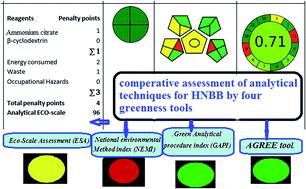当前位置:
X-MOL 学术
›
Anal. Methods
›
论文详情
Our official English website, www.x-mol.net, welcomes your feedback! (Note: you will need to create a separate account there.)
Comparative study of four greenness assessment tools for selection of greenest analytical method for assay of hyoscine N-butyl bromide
Analytical Methods ( IF 3.1 ) Pub Date : 2020-12-16 , DOI: 10.1039/d0ay02169e Mohammed Gamal 1, 2, 3, 4, 5 , Ibrahim A. Naguib 1, 5, 6, 7, 8 , Dibya Sundar Panda 2, 3, 4, 5, 9 , Fatma F. Abdallah 10, 11, 12, 13, 14
Analytical Methods ( IF 3.1 ) Pub Date : 2020-12-16 , DOI: 10.1039/d0ay02169e Mohammed Gamal 1, 2, 3, 4, 5 , Ibrahim A. Naguib 1, 5, 6, 7, 8 , Dibya Sundar Panda 2, 3, 4, 5, 9 , Fatma F. Abdallah 10, 11, 12, 13, 14
Affiliation

|
Several assessment tools were recently introduced for the evaluation of the greenness of analytical methods. Each tool has advantages, disadvantages, and a unique assessment protocol. The final results obtained from each assessment tool may lead to a dissimilar conclusion about the selection of the greenest method, which makes the decision confusing as to which an assessment tool relies on. Accordingly, in this comparative case study, four greenness assessment tools—National Environmental Methods Index (NEMI), Eco-Scale Assessment (ESA), Green Analytical Procedure Index (GAPI), and Analytical GREEnness metric (AGREE)—were tested to evaluate 16 chromatographic methods described in the literature for the assessment of the commonly used antispasmodic drug Hyoscine N-butyl bromide (HNBB). The importance of applying more than one assessment tool when evaluating the greenness of analytical methods is explained in this study. Despite NEMI tool simplicity, it was the least effective in providing information about the analytical method as 14 out of 16 methods had the same NEMI pictogram. ESA and AGREE provided reliable numerical assessments that differed in their total scores whereas the total scores were out of 100 and 1 for each, respectively. AGREE has the merits over ESA with respect to automation and highlighting the weakest points in analytical techniques that need further improvements in terms of greenness. GAPI and AGREE provide fully descriptive three-colored pictograms. The main disadvantage of GAPI is complexity compared to NEMI and ESA. AGREE has the merits of simplicity and automation over GAPI. Based on the results, recommendations are made for ESA, GAPI, and AGREE tools, which provide reliable and precise results about the greenness of the method. Planning for the greenness of analytical methods should be assured before practical trials in a laboratory for reduction of chemical hazards released into the environment. Moreover, inclusion of the evaluation of greenness of analytical methods in method validation protocols is strongly recommended.
中文翻译:

四种绿色度评估工具选择最绿色的分析方法进行比色法测定丝氨酸正丁基溴的比较研究
最近引入了几种评估工具,用于评估分析方法的绿色程度。每个工具都有优点,缺点和独特的评估协议。从每个评估工具获得的最终结果可能会得出关于选择最绿色方法的不同结论,这会使评估工具所依赖的决策产生混乱。因此,在此比较案例研究中,对四个绿色评估工具(国家环境方法指数(NEMI),生态规模评估(ESA),绿色分析程序指数(GAPI)和分析GREEnness度量标准(AGREE))进行了测试,以评估16文献中描述的色谱方法用于评估常用的解痉药物Hyoscine N丁基溴化物(HNBB)。在这项研究中,说明了在评估分析方法的绿色程度时使用多个评估工具的重要性。尽管NEMI工具简单易行,但在提供有关分析方法的信息方面效率最低,因为16种方法中有14种具有相同的NEMI象形图。ESA和AGREE提供了可靠的数字评估,其总分有所不同,而总分分别为100分和1分。AGREE在自动化方面具有优于ESA的优点,并突出了分析技术中最薄弱的环节,需要在绿色方面进行进一步改进。GAPI和AGREE提供了完全描述性的三色象形图。与NEMI和ESA相比,GAPI的主要缺点是复杂性。与GAPI相比,AGREE具有简单性和自动化的优点。根据结果,对ESA,GAPI和AGREE工具提出了建议,这些工具可提供有关该方法绿色性的可靠且精确的结果。为了减少释放到环境中的化学危险,在实验室进行实际试验之前,应确保对分析方法的绿色进行规划。此外,强烈建议将分析方法的绿色评估纳入方法验证协议中。
更新日期:2021-01-06
中文翻译:

四种绿色度评估工具选择最绿色的分析方法进行比色法测定丝氨酸正丁基溴的比较研究
最近引入了几种评估工具,用于评估分析方法的绿色程度。每个工具都有优点,缺点和独特的评估协议。从每个评估工具获得的最终结果可能会得出关于选择最绿色方法的不同结论,这会使评估工具所依赖的决策产生混乱。因此,在此比较案例研究中,对四个绿色评估工具(国家环境方法指数(NEMI),生态规模评估(ESA),绿色分析程序指数(GAPI)和分析GREEnness度量标准(AGREE))进行了测试,以评估16文献中描述的色谱方法用于评估常用的解痉药物Hyoscine N丁基溴化物(HNBB)。在这项研究中,说明了在评估分析方法的绿色程度时使用多个评估工具的重要性。尽管NEMI工具简单易行,但在提供有关分析方法的信息方面效率最低,因为16种方法中有14种具有相同的NEMI象形图。ESA和AGREE提供了可靠的数字评估,其总分有所不同,而总分分别为100分和1分。AGREE在自动化方面具有优于ESA的优点,并突出了分析技术中最薄弱的环节,需要在绿色方面进行进一步改进。GAPI和AGREE提供了完全描述性的三色象形图。与NEMI和ESA相比,GAPI的主要缺点是复杂性。与GAPI相比,AGREE具有简单性和自动化的优点。根据结果,对ESA,GAPI和AGREE工具提出了建议,这些工具可提供有关该方法绿色性的可靠且精确的结果。为了减少释放到环境中的化学危险,在实验室进行实际试验之前,应确保对分析方法的绿色进行规划。此外,强烈建议将分析方法的绿色评估纳入方法验证协议中。


























 京公网安备 11010802027423号
京公网安备 11010802027423号